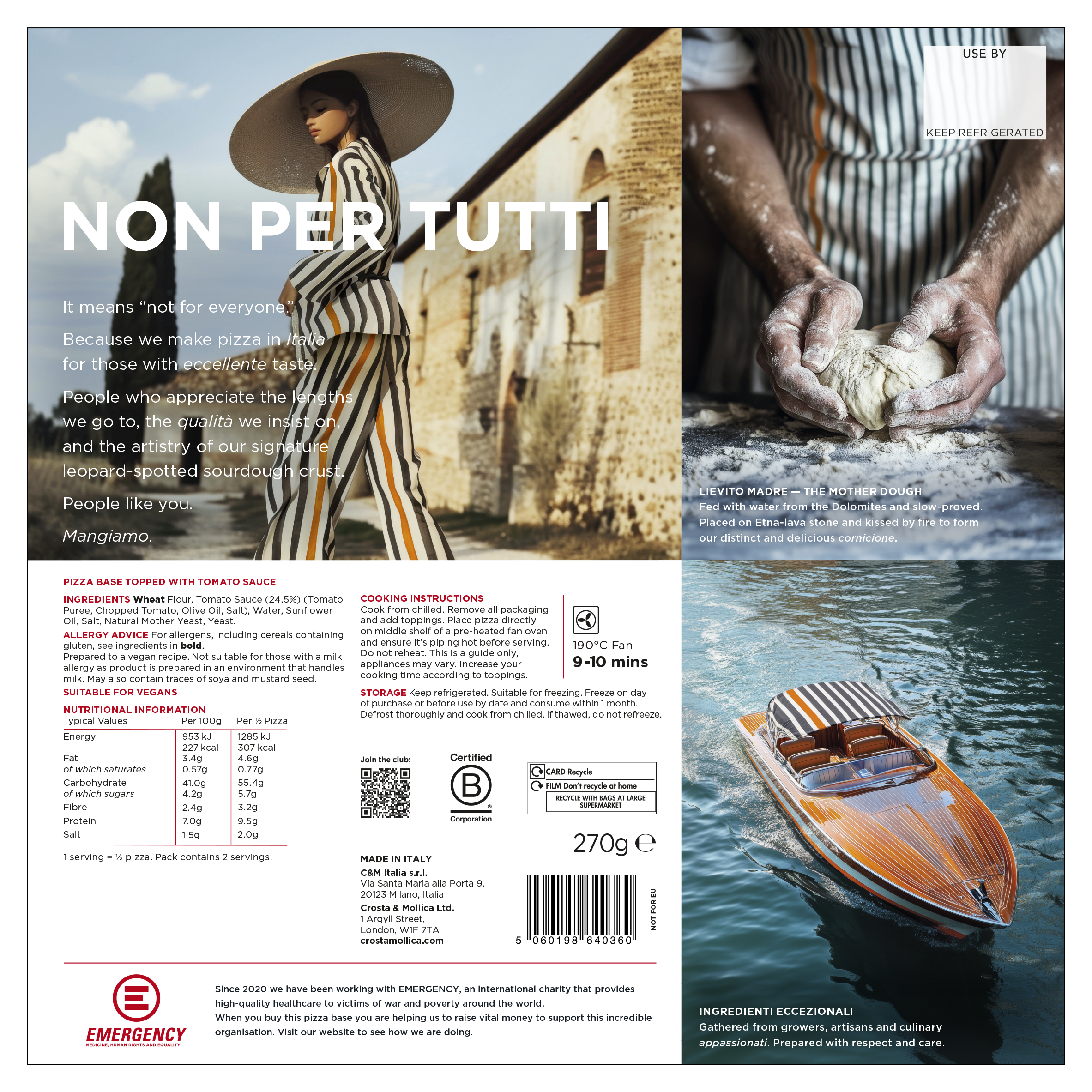Crosta Mollica was acquired by private equity firm Perwyn in January 2024 and has reported significant growth in its part-year accounts for the period from acquisition (12 January 2024) to year end (30 June 2024).
Gross sales in the group for the 12-month period ending 30 June 2024, versus the 12-month period ending 30 June 2023, grew by 39%: with growth of 39% in the UK and 45% in international markets. For context, in the same period, key competitors showed little or no growth.
Particularly noteworthy is the success of Crosta Mollica’s core category, pizza, which saw growth of 46%. The wider non-pizza product portfolio delivered an overall increase of 29%.
This year’s gross sales performance takes the business’s compound annual growth rate to 36% over the last three years.
This year has also seen Crosta Mollica unveil a new brand refresh as it looks to reinforce its Italian roots and cement its brand name and premium status.
What’s in a name?
“It was visually quite well recognised,” David Milner, chairman for Crosta Mollica told Food Manufacture. “But if you ask people to name an Italian premium pizza brand, less than 5% of the population said Crosta Mollica.
“For a brand with retail sales of well over £100 million, I find that quite interesting – that you can have a brand that’s seen everywhere but no one can recall the name.”
One of the changes to its look is the resizing of the brand name – which had previously been trumped by the visually arresting stripy packaging.
“Historically, the brand name was the third biggest thing and was written in black and yellow; so when you glanced at the product – and most products only get a glance – the first thing you saw was not the brand name."
Milner reasoned this is why people aren’t remembering the name.
“So we changed the hierarchy around, now the biggest thing on the pack is the brand name.”
To make it even easier for consumers, the word ‘Crosta’ is also bigger than ‘Mollica’ and the ampersand has been ditched.
Milner added that it will be a big win if people just remember the ‘Crosta’ part.
Originally, the branding for both its chilled and frozen pizzas had been the same, but with its sales split equally between the two aisles, Milner said it was key to consider how the look worked within the differing retail space.
During the rebrand, the business spent a lot of time eyeing the shelf space of the supermarket and noticed that whilst most chilled cabinets are brightly lit, the same cannot be said for the frozen aisle.
“It tends to be behind frosted glass or in a dark chest freezer,” he said.
To cater for this, the brand tweaked the design of the frozen pizzas.
The chilled pizzas packs feature a pop of colour that marries up with the flavour. For example, its Fiorentina pizza has a green background – a nod to its spinach topping. Meanwhile, its entire frozen range has a white marble background.
“It’s a lighter, brighter visual” that helps it “stand out” in the dark freezer cabinets.
AI image generation
Alongside playing with typography and colour, the brand has also been utilising imagery to help make the products embrace its Italian identity – with Crosta Mollica products manufactured in Italy before being imported to the UK for sale.
The design company Crosta Mollica is working with – Big Fish – surprised Milner by showcasing a range of designs with featured ‘Italian activities’ such as riding on Vespas and models by the sea.

“I was amazed how quickly they managed to shoot all these images – and slightly concerned – I was thinking ‘you’ve gone from concept to finished article and I didn’t really give you the authority to cast, fly out to Venice etc’. But nevertheless, I thought they were brilliant.”
But the company hadn’t done any of those things – instead it had used artificial intelligence (AI) to create the imagery.
“They said ‘no, we didn’t go anywhere. None of this is real, David. All of it’s been done on a computer. It didn’t take long at all’.
“That was my first experience with AI. It is remarkable how it’s changed the ability to get really perfect content shots in huge quantities very quickly. It goes without saying that it’s much cheaper as well.”
Milner added that the use of AI for image creation affords brands with more flexibility to play with its look, enabling brands to have different images for different product types.
“In the past if you had 10 different pizzas, you’d need a different set of photographs for each one.”
Speaking further on AI, Milner believes its use will continue to grow until we reach a point where we won’t have “any idea if what we’re looking at is real or not”.
“In one or two years, you won’t be able to tell what’s what unless you actually meet someone in the flesh,” he ventured.
For Milner, he says this will drive up the importance of physical meetings with people.
“Meeting up physically will become more valuable because that’ll be the only time you truly know it’s an authentic experience.”
He added that this “doesn’t mean AI is bad”, noting that it will need to be embraced in some respects whilst handled with caution in others.
He explained that it’s about identifying what tasks are transactional and where things can be made more efficient with technology.
“And then there are other things that you make decisions on – probably less frequently – that are absolutely critical to the future of business, where you want high quality interaction and high quality discussion.”
Regardless, he says it is vital businesses embrace “the new, the innovative and the fresh approaches to thinking and business”.
“There’s no such thing as standing still. If you don’t change, you start to go backwards.
“We all have to evolve, the tricky thing in life is making sure you make the right decisions along the way. But I don’t think you can have a closed mind to AI.”
The AI images are now being rolled across the Crosta Mollica brand (see above picture) on its back of pack, helping it to reinforce its Italian roots in what Milner describes as a much more affordable and efficient manner.
The new look has also been supported by a £1 million (media value) investment major investment into a series of immersive retail activations across the UK’s ‘Big Four’ supermarkets, with last month also seeing two new pizza SKUs revealed.


